Crete December 2018

Crete
1st to 8th December, 2018.
After lots of discussion regarding the thoughts of taking
Ariel to Crete one summer we decided to join a tour of
Crete by flying to the island in December.
Crete is renowned for its Greek ancient cities, white
mountains and stunning coastal stretches.
Day1
On the Sunday we visited the Monastery of Arkadi. Its
a Eastern Orthodox monastery situated 14 miles
southeast of Rethymnon. The current church dates back
to the 16th century when it was a place for science and
art and had a school and a rich library. It played an
active role in the Cretan resistance of Ottoman rule
during the revolt of 1866. 943 Greeks mostly women
and children sought refuge in the monastery. After three
days of battle and under orders from the abbot of the
monastery the Cretans blew up barrels of gunpowder
choosing to sacrifice themselves rather than surrender.
The monastery became a national sanctuary in honour
of the Cretan resistance celebrated on the 8th November
each year. The explosion did not end the Cretan
insurrection but it attracted the attention of the rest of
the world.
Elefterna museum was created about thirty years ago to
accommodate the excavations of the ancient city for
Homer in Crete. It is a very organised and beautified
presented museum. It is divided into three rooms.
Room A has displays of vases, sculptures, weapons,
tools, figurines from clay, stone and metal. Room B
presents religious life and cults at Eleuthernia from the
early Iron Age to the Byzantine era. It also houses one
of the earliest monuments to the unknown soldier in
world history. Room C is dedicated to the ritual of
funeral pyres and those buried in what is called
Building M contained four women aged 13.5 to 72
years who would had held prominent positions in the
Early Archaic society of Eleutherna.
We had a wonderful lunch in a harbour restaurant in
Rethymon and walked around the old town. Rethymon
is a city on the north coast between Chania and
Heraklion. In the old town the Venetian Harbour is
filled with fishing boats and line with tavernas.
Rethymon Lighthouse was built in the 1830s. On the
hilltop you can see the Fortezza a star shaped 16th
century church. The long sandy beach stretches to the
east and are among the most popular beach resorts on
the island. There are lots of lovely little shops selling all
sorts of island pottery, pots of honey, paintings and
sweets.
Day 2
We went high into the mountains to Argyroupolis to see
the famous waterfalls and the view over the valley and
then onto Lake Kournas and Kournas which is a fairly
large village perched on a hill overlooking the lake. Our
coach took us onto the Aptera archaeological site and
then the Hagia Triada an ancient Minoan settlement.
The lunch time stop was in Chania. A beautiful town
where we had lunch and a walk around this very
interesting town. The Venetian harbour, the old port,
the narrow shopping streets and waterfront restaurants
together with the old buildings give you a feeling of
Venetian and Turkish design. This town gave us an
appetite for a return visit one day.
Day 3
On the Akrotiri peninsula we visited the famous Agia
Triada Monastery known as a Venetian masterpiece.
The monastery whose name means “Holy Trinity” was
built in the 17th century by two brothers of the Venetian
Zangaroli family on the site of a pre existing church.
The monks produce and sell wine and olive oil on the
premises. The monastery has a library which contains
some rare books which contains a collection of icons
and a collection of codices. An important icon is of St
John the Theologian dated to around 1500.
We visited Lake Kournas the only freshwater lake in
Crete near the village of Kournas a large village
perched on a hill overlooking the lake. The landscape is
enchanting.
On our travels we stopped at the tomb of the great
Cretan statesman Eleftherios Venizelos in order to
enjoy the scenery and views of Chania before driving
into Chania for lunch.
This has a wonderful port where we were able to stroll
around the little alleys and walk through the market hall
before enjoying a nice lunch in a small restaurant. We
discovered the Jewish quarter of Evraiki. If you stand in
the square facing the sea the area to the left (west) is
called Evraiki.
We were lucky enough to see the White Mountains
which gave us such a panoramic view.
Day 4
This is the day we visited Matala where in the 60’s it
was a hippie paradise. For all those who didn’t want to
fight and go to the Korean war they found their way
there by ferry and lived in the cliffs in caves living the
hippie life. Joni Mitchell the folk singer lived there with
her friend singing her folk songs under the starry sky.
Finally the military junta and the church drove them
out. The caves had originally housed lepers at the end
of the Stone Age and then the Romans used them as
burial crypts. When the hippies arrived searching for
peace and enlightenment the caves became the cheapest
hotel in town.
We visited the Minoan Palace of Phaistos located in the
south central Crete. It is one of the most important
archaeological sites in Crete with many thousands of
visitors annually. The Minoan place of Phaistos
corresponds to a flourishing city which arose in the
fertile plain of the Messara in prehistoric times from
circa 6000 BC to the 1st century BC as archaeological
finds confirm. The first palace of Phaistos was built in
2000 BC by its founder of Minos himself and its first
king was his brother Radamanthys. In 1700 BC a strong
earthquake destroyed the palace and it was rebuilt
almost immediately. Phaistos was no longer the
administrative centre of the area but it continued to be
the religious and cult centre of south Crete. In 1450 BC
was another great catastrophe not just in Phaistos but
across the whole of Crete. The city of Phaistos
recovered from the destruction, minted its own coins
and continued to flourish for the next few centuries
until the first century BC when it was destroyed by
neighbouring Gortys.
The first excavations in the wider area of Phaistos was
undertaken in 1900 by the Italian Archaeological
School and continued until the Second World War.
Most of buildings visible today belong to the
Neopalatial period (1700 to 1450 BC). A brilliant site to
visit.
Day 5
Another archaeological site today. This time it was the
Malia Minoan Palace. It was discovered in 1915 by
Joseph Hadzidakis. It dates from the Middle Bronze
age which was destroyed by an earthquake. It was
rebuilt and the ruins we see today were from the
rebuild.
We also visited the Keras Kardiotissas Monastery or
simply known as the Keras Monastey is an Eastern
Orthodox monastery dedicated to Virgin Mary situated
in the village of Kera. It is still inhabited by nuns and
and today it is one of Crete’s most important
monasteries of Crete dedicated to the Virgin Mary.
Day 6
We hired a car and visited Agias Nicholaros and met up
with Tony Cross a regular Cruising Association
contributor for a drink who gave us a great tour of the
town before we drove to Spinalonga and exploded the
small island.
Crete isn’t for Ariel as the harbours are small and very
rocky with very little depth and there are very few not
to mention the very strong winds during the summer
months but another holiday there by plane is on the
cards.




